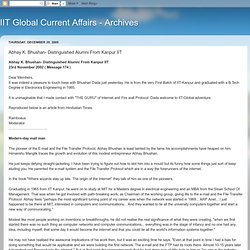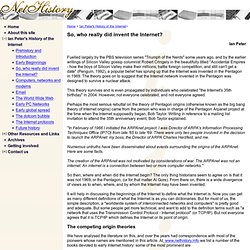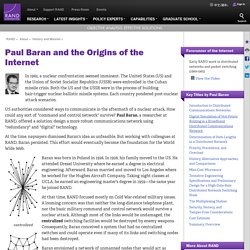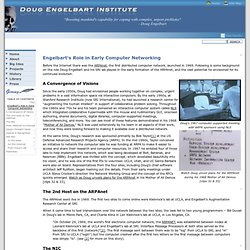Zoom
Trash

Center: About Jon Postel. Jon Postel, Internet Pioneer August 6, 1943 - October 16, 1998 "Be liberal in what you accept, and conservative in what you send. " -- jon RFC-1122 (originates in RFC760) "Jon has been our North Star for decades ... He was the Internet's Boswell and its technical conscience.
" -- Vint Cerf About Our Namesake Click here for public relations material. Jon was many things to many people in the Internet: In its infancy, Jon worked on its development, from its early protocols, to the creation of TCP/IP. Howard rheingold's. General Overview. The IT Godfather Speaks: Q&A With Charles M. Herzfeld. By Gary Anthes September 24, 2007 12:00 PM ET Computerworld - Is DARPA still funding the kinds of research that made the U.S. an IT leader?

Charles M. Charles Herzfeld. Charles Herzfeld served as director of the Advanced Research Projects Agency (ARPA) in the 1960s.

Under his leadership, he recognized the importance of computers and oversaw the decision for the creation of ARPANET, which eventually became the Internet. Born in Vienna, he came to the US in the 1940s and earned a BS degree from Catholic University of America and a PhD from University of Chicago. After leaving ARPA, he was the vice president for research and technology at ITT Corporation, director of defense research and engineering in the Department of Defense, and senior consultant to the presidential science adviser.
He has been a member of the Chief of Naval Operations Executive Panel since its formation in 1970. ARPANET Main Page. And the Birth of the Internet - Special Report. Computer History Museum - Exhibits - Internet History - 1970's. Abhay Bhushan. What is File Transfer Protocol (FTP)? FTP, File Transfer Protocol, is a protocol through which internet users can upload files from their computers to a website or download files from a website to their PCs.

Originated by Abhay Bhushan in 1971 for use in the military and scientific research network known as ARPANET, FTP has evolved into a protocol for far wider applications on the World Wide Web with numerous revisions throughout the years. FTP is the easiest way to transfer files between computers via the internet, and utilizes TCP, transmission control protocol, and IP, internet protocol, systems to perform uploading and downloading tasks. How It Works. Abhay K. Bhushan- Distinguished Alumni From Kanpur IIT. Abhay K.

Bhushan- Distinguished Alumni From Kanpur IIT23rd November 2002 ( Message 174 ) Dear Members,It was indeed a pleasure to touch base with Bhushan Dada just yesterday. Computer History Museum - Exhibits - Internet History. WSJ mangles history to argue government didn’t launch the Internet. "It's an urban legend that the government launched the Internet," writes L. Gordon Crovitz in Monday's Wall Street Journal, launching into just one of a myriad of problems with his short opinion piece.
Origins of the Internet. Ian Peter Fuelled largely by the PBS television series "Triumph of the Nerds" some years ago, and by the earlier writings of Silicon Valley gossip columnist Robert Cringely in the beautifully titled "Accidental Empires - how the boys of Silicon Valley make their millions, battle foreign competition, and still can't get a date" (Penguin, 1992), a popular belief has sprung up that the Internet was invented in the Pentagon in 1969.

The theory goes on to suggest that the Internet network invented in the Pentagon was designed to survive a nuclear attack. This theory survives and is even propagated by individuals who celebrated "the Internet's 35th birthday" in 2004. However, not everyone celebrated, and not everyone agreed. Leonard Kleinrock's Home Page. Below is a record of the first message ever sent over the ARPANET.

It took place at 22:30 hours on October 29, 1969. This record is an excerpt from the "IMP Log" that was kept at UCLA. Professor Kleinrock was supervising his student/programmer Charley Kline (CSK) and they set up a message transmission to go from the UCLA SDS Sigma 7 Host computer to another programmer, Bill Duvall, at the SRI SDS 940 Host computer. Paul Baran and the Origins of the Internet. In 1962, a nuclear confrontation seemed imminent.

Engelbart's Role in Internet/ARPANET History - Doug Engelbart Institute. Before the Internet there was the ARPAnet, the first distributed computer network, launched in 1969.

Following is some background on the role Doug Engelbart and his SRI lab played in the early formation of the ARPAnet, and the vast potential he envisioned for its continued evolution. Since the early 1950s, Doug had envisioned people working together on complex, urgent problems in a vast information space via interactive computers. By the early 1960s, at Stanford Research Institute (now SRI International), he had launched a research center for "augmenting the human intellect" in support of collaborative problem solving.
Throughout the 1960s and '70s he and his team pioneered an interactive computer system called NLS which integrated collaborative hypermedia with the mouse and rudimentary GUI, onscreen authoring, shared documents, digital libraries, computer-supported meetings, teleconferencing, and more. You can see most of these features demonstrated in his 1968 "Mother of All Demos. " @CHM : Arpanet. ARPANET Maps. History of Email & Ray Tomlinson. Computer engineer, Ray Tomlinson invented internet based email in late 1971.

Under ARPAnet several major innovations occurred: email (or electronic mail), the ability to send simple messages to another person across the network (1971). Ray Tomlinson worked as a computer engineer for Bolt Beranek and Newman (BBN), the company hired by the United States Defense Department to build the first Internet in 1968. Ray Tomlinson was experimenting with a popular program he wrote called SNDMSG that the ARPANET programmers and researchers were using on the network computers (Digital PDP-10s) to leave messages for each other. SNDMSG was a "local" electronic message program.
You could only leave messages on the computer that you were using for other persons using that computer to read. ARPANET Maps.